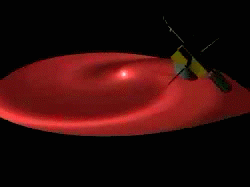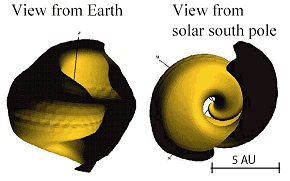|
Sometimes the Sun's magnetic field goes haywire,
and the effects are felt throughout the solar system.
by Dr Tony Phillips
Three years ago, something
weird happened to the Sun.
Normally, our star,
like Earth itself, has a north and a south magnetic pole. But for
nearly a month beginning in March 2000, the Sun's south magnetic
pole faded, and a north pole emerged to take its place. The Sun
had two north poles.
"It sounds impossible,
but it's true," says space physicist Pete Riley of Science Applications
International Corporation (SAIC) in San Diego. "In fact, it's a
fairly normal side-effect of the solar cycle." Every 11 years around
solar maximum, the Sun's magnetic field goes haywire as the Sun's
underlying magnetic dynamo reorganizes itself. The March 2000 event
was simply a part of that upheaval.
"The south pole never
really vanished," notes Riley. It migrated north and, for a while,
became a band of south magnetic flux smeared around the Sun's equator.
By May 2000 the south pole had returned to its usual spot near the
Sun's southern spin axis - but not for long. In 2001 the solar magnetic
field completely flipped; the south and north poles swapped positions,
which is how they remain now.
Using a supercomputer
named Blue Horizon and data from spacecraft (especially NASA's ACE
and ESA-NASA's Ulysses) Riley and colleagues are studying how these
complex changes can affect our planet. "The Sun's magnetic field
permeates the entire solar system," explains Riley. "It interacts
with Earth and is the primary driver of space weather."
The vast region of
space filled by the Sun's magnetic field is called the heliosphere.
All nine planets orbit inside it. But the biggest thing in the heliosphere
is not a planet, or even the Sun. It's the current sheet - a sprawling
surface where the polarity of the Sun's magnetic field changes from
plus (north) to minus (south). "We call it the 'current sheet,'"
says Riley, "because an electrical current flows there, about 10-10
amps/m2." The filament of an ordinary light bulb carries
sixteen orders of magnitude (1016x) more amps/m2.
But what the current sheet lacks in local amperage, it makes up
in sheer size. The sheet is 10,000 km thick and extends from the
Sun past the orbit of Pluto. "The entire heliosphere is organized
around this giant sheet."

Credit: Brian Grimm and LivingText
An artist's
concept of the heliospheric current sheet. The rotating
Sun is located in the centre.
|
Ordinarily, the current
sheet circles the Sun's equator like a wavy skirt around a ballerina's
waist. But during the double north pole event of March 2000, the
current sheet was radically altered: The waviness increased. Irregularities
appeared. Its topology "morphed" from a ballerina's skirt to a giant
seashell.
Interesting to a solar
physicist, perhaps...
Ordinarily, the current
sheet circles the Sun's equator like a wavy skirt around a ballerina's
waist. But during the double north pole event of March 2000, the
current sheet was radically altered: The waviness increased. Irregularities
appeared. Its topology "morphed" from a ballerina's skirt to a giant
seashell.
Interesting to a solar
physicist, perhaps...
...but ordinary people
should care about this, too. First because of energetic cosmic rays:
The current sheet acts as a barrier to cosmic rays traveling through
the heliosphere. Cosmic rays can't cross the
sheet; instead they flow along it. The shape of the current sheet
therefore determines how many cosmic rays strike Earth.
Space
weather is another reason: As
Earth orbits the Sun, it dips in and out of the undulating current
sheet. On one side the Sun's magnetic field points north (toward
the Sun), on the other side it points south (away from the Sun).
South-pointing solar magnetic fields tend to cancel Earth's own
magnetic field. Solar wind energy can then penetrate the local space
around our planet and fuel geomagnetic storms.

Photo credit and copyright:
LeRoy Zimmerman
These
auroras appeared over Alaska's Knik Valley during a strong
geomagnetic storm on April 8, 2003.
|
Geomagnetic storms are
both good and bad - bad because they can cause electronics on satellites
to short circuit and power grids on Earth to fail; good because
they spark auroras, which sky watchers enjoy. "If we could make
an accurate daily map of the current sheet, then we could do a better
job predicting the onset of these storms."
There's a problem,
though: the current sheet is invisible. "We can't see it through
an optical telescope," he says, "which means we have to calculate
where it is." Riley and his colleagues have developed a computer
program to do that. The input data are measurements
of the Sun's surface magnetic field; these are taken daily by telescopes
on Earth. The program applies the equations of resistive magnetohydrodynamics
to calculate how the electrified solar wind drags that magnetic
field through the solar system. A supercomputer - Riley uses the
Blue Horizon IBM SP3 at the San Diego Supercomputing Centre. - is
required to execute the code.
The episode of the
double north pole provided a key test of their software. "We calculated
the shape of the current sheet for a Sun with two north poles,"
recalls Riley. "The result looked like a conch shell ... more than
a billion kilometres wide."
But how could he check
his results?
NASA's Ulysses spacecraft
provided the crucial data. In early 2000, Ulysses was about 600
million km from the Sun - perfect for testing the conch model. As
the spacecraft cruised through space at 10 km/s it crossed the current
sheet twice, once in March and again in April 2000. Onboard magnetometers
recorded the crossings, which were in good agreement with Riley's
predictions.

The shape
of the current sheet in March 2000 as calculated by the
Blue Horizon supercomputer.
|
Using only measurements
of the Sun's surface magnetic field, his software had successfully
predicted magnetic fields in interplanetary space 600 million km
away. Impressive.
"It has taken us ten
years to develop this capability," says Riley. "We would like to
improve it even more by including measurements of the temperature,
density and speed of the solar wind - parameters that we merely
estimate now. Our ultimate goal is to provide up to 4 days advance
warning of geomagnetic storms."
Testing that next-generation
software will require more data from Ulysses. The spacecraft follows
a high-looping orbit where it can see the Sun's polar regions -
something no other spacecraft can do. "This unique trajectory has
allowed scientists for the first time to fully explore the heliosphere
in three dimensions," says Riley.
A supercomputer on
Earth. A spacecraft hundreds of millions of kilometres away. Working
together they're getting us ready for the next time the Sun sprouts
an extra north pole ... or something stranger yet.
|
